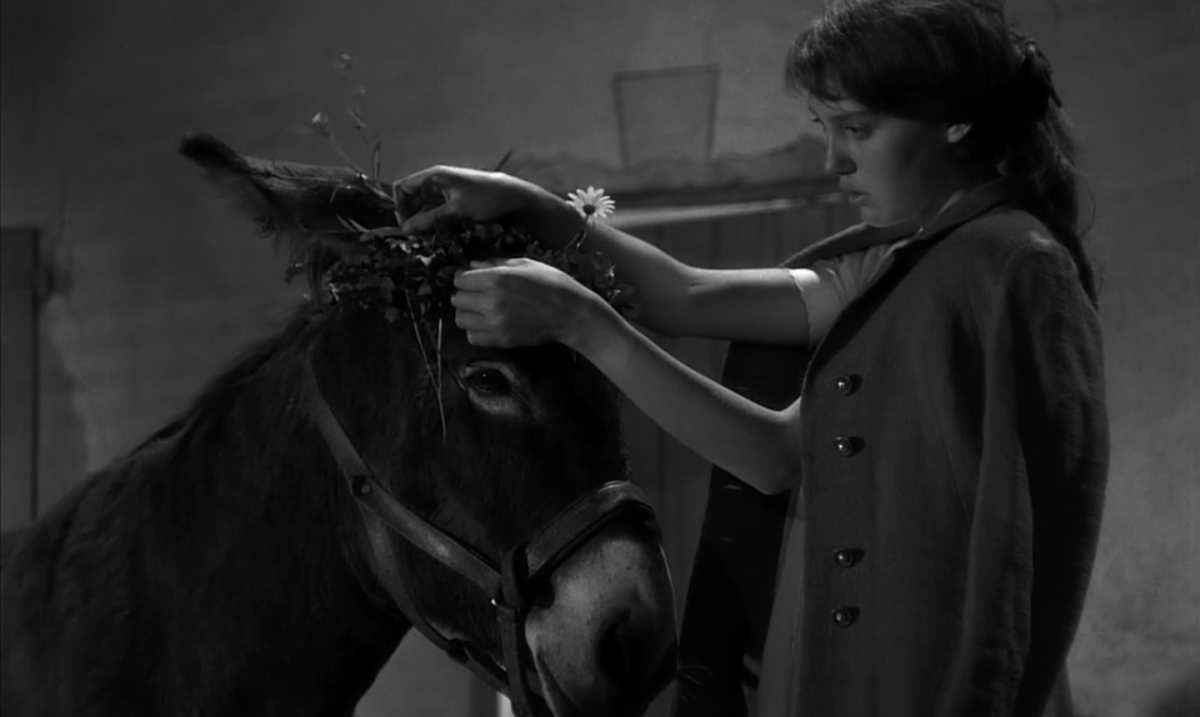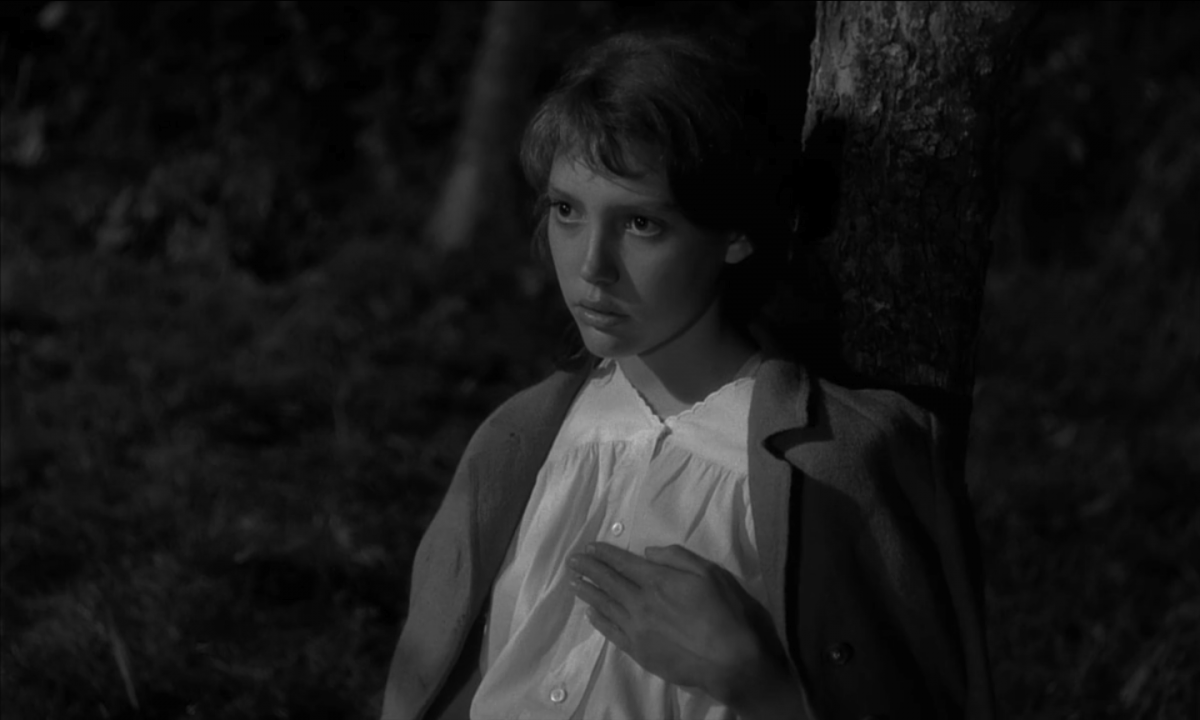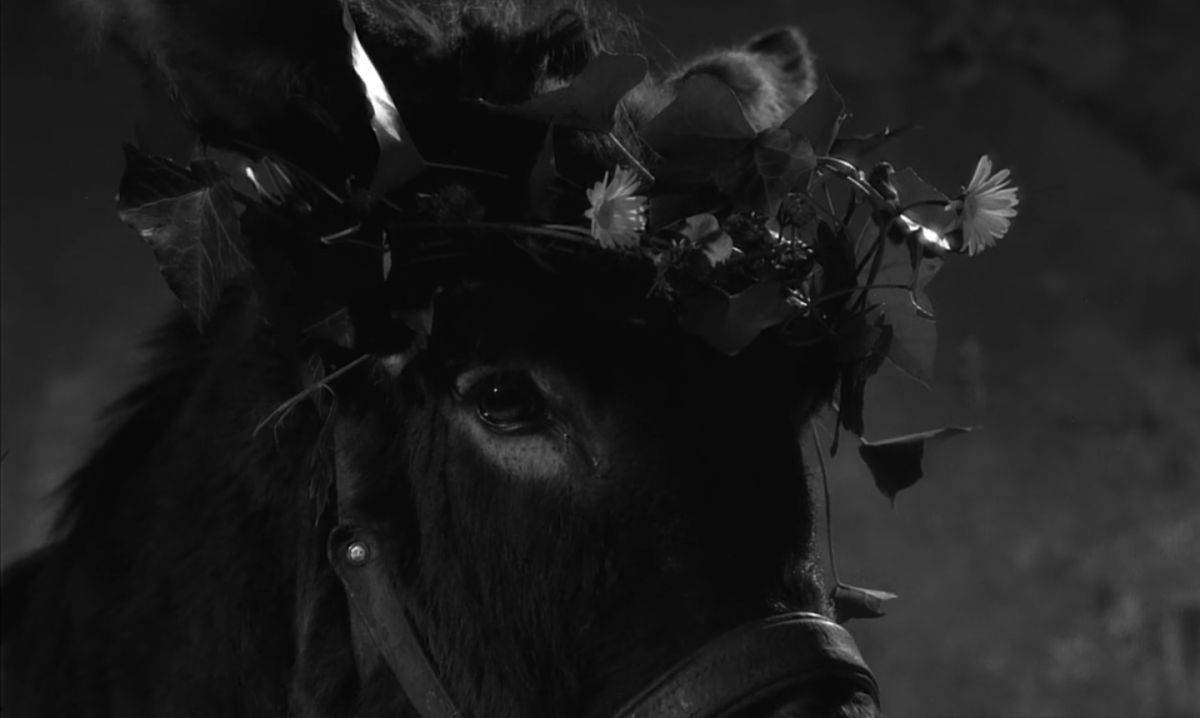Au hasard Balthazar by Robert Bresson

At the beginning of the film, children are playing at baptism. They push the salt of wisdom between the teeth of a small donkey whose head looks as crumpled as that of a newborn and give him the name of the third king who brought myrrh to the baby Jesus in the stable of Bethlehem. At the end of the film, Balthazar dies from the bullets of customs officers when transporting contraband from the French to the Spanish Pyrenees. Apart from the somewhat unusual beginning and end, Balthazar has a typical fate for a donkey: good and bad owners, good and bad days, he is maltreated and takes revenge in his own way, and every now and then for reasons unknown he starts braying, hoarsely and monotonously.
Bresson does everything he can to meet the idea we have of a donkey. He does not show a particularly picturesque animal story with a deeper meaning; he evokes something familiar. He does not tell a history of the donkey, but uses one donkey story as a grid, as a structural principle of his film, even more easily recognisable for French viewers because entire blocks seem to have been taken from a famous children’s book: Mémoires d’un âne [Memoirs of a Donkey] by the Countess of Ségur. Indeed, her story contains all the sentimentality that the opponents of this film believe to be the film’s very own fabrication.
But Bresson not only counts on the spectators’ automatic imagination, their memories of ancient culture, of Christian tradition, the echo of stories from childhood, thereby almost predestining the donkey to appear as the representation of syncretism in the broadest sense; he also piles up literary and cinematographic commonplaces: he inserts the familiar phrase “years went by”; we see Balthazar waiting in the same place in spring, summer, autumn and winter; we are reminded of American comedies with the familiar gag in which an expected car collision is not shown, but only represented acoustically. Bresson reveals them to be the artifice they are. Balthazar the donkey is a depicted symbol, his story the depicted thread with which filmmakers commonly transform the coincidences and inconsistencies of life into logical and probable stories whose forced unambiguity appears to the viewer as reality.
A true narrative device, Balthazar is the only one in this film who has a real destiny with a real beginning and a real end, while the lives of those he comes into contact with only tangentially touch his: the ambitious village teacher whose pride plunges his family into misfortune; the notorious drunk Arnold who guides tourists through the mountains on donkeys; the grain merchant whose life is filled with greed and who almost beats Balthazar to death; the jealous, childless baker’s wife; the parentless Gerard, who delivers bread but is above all a smuggler, and whose rowdy look is as unusual for a baker’s boy as the way in which he carries out his profession: he rides a moped through the area, pulling the bread-laden Balthazar behind him on a chain.

And then there is Marie, the teacher’s daughter, whose facial expression is a strange mixture of Madonna-like and sensual. She was there as a little girl when Balthazar was baptised. In shots that – without flashbacks and using only realistic means – are surrounded by an aura that makes them appear as pure memory-images, Bresson depicts the childhood love between Marie and Jacques, a little boy from the city whose father owns a holiday home next to the village school. The donkey, too, belongs to the little boy. The relationship between the children is illustrated by their affection for Balthazar. When the city people give up their piece of land, the donkey becomes the teacher’s property. The donkey is there when Marie and Jacques meet again, when the eternal love they promised each other as children fails due to the villagers’ jealousy and Marie’s father’s obstinacy. The donkey is sold when Marie no longer wants to feed him out of disappointment with Jacques, and his presence plays a part when, out of defiance and disappointment, she convinces herself that she loves Gerard, whose provocative and aggressive advances initially provoked only disgust.
The donkey provokes behaviour and the people project their feelings onto him; after he as a filmmaker has set the course, Bresson is only interested in the relationships that automatically arise between the people and the animal. “Films are not meant to copy life, but to draw us into a rhythm that must be set by the filmmaker... The truth should not be sought in facts, not in people and things, but in the emotion they evoke. The truth of emotion is what teaches and guides us.”1 A particularly striking example of this intention is the sequence in which Marie adorns the donkey one night. Countless examples from literature could be given for the portrayal of the capacity to love that is looking for an object, for the portrayal of an emotional situation in which childlike helplessness and restlessness are mixed. What is absolutely new about Bresson is the fact that, in a seemingly completely familiar situation, he exposes an aspect that can only be revealed through cinematic means. No literary description of muteness, however eloquent, could depict the essence of speechlessness and the subconscious as well as this scene between the passive animal and the girl who, like a somnambulist, kisses the donkey and attaches flowers to its forehead.
Bresson starts from familiar premises; his characters come straight out of the Great Theatre of the World. He only connects them with each other; these initially completely neutral elements enter into a movement that does not depend on stories and characters as usual, but on insights that arise from pure confrontation, which in turn does not owe its emergence to preconceived concepts but touches the audience directly and abruptly, without rhetorical help. That is why he rejects the use of dramaturgical recipes and professional actors. For him, theatre and vulgarised theatre, as he sees it everywhere in cinema, are imitation art that reproduces well-considered and thought-out feelings. He is looking for that which is concealed, not yet thought, which arises from the combination of different elements, which the combined structure of the film medium is better suited to find than any other medium: “For me, it is about taking pieces of reality from people and things, isolating them, making them independent and giving them a different order, a different coherence. The importance of the ‘montage’ is obvious, because only when image and sound come into contact with each other and each take their place does the film come into being. In coming into being, the film gives life to the characters, not the other way around.”2
Behind statements of this kind is a conception of art that guarantees detailed precision and concentration on the fragmentary, so that the multiplicity of reality is not violated. Bresson’s experience of the indeterminacy of everyday life fills his films with cut-outs, hands and feet, parts of things, ellipses, which is why the human stories he presents are full of blind spots. His creations must be completed at every moment, first by his actors and then by his spectators. He only suggests possibilities, which can subsequently be developed in the most diverse ways. His films are thus never self-contained static compositions; their limitation to one small aspect makes it possible to depict the infinite. In this respect, too, the story and the figure of Balthazar the donkey are a represented aesthetic fact, a means not of representing reality but of referring to it. The notorious manner of speaking and acting of Bresson’s amateur actors belongs to the same kind of considerations; they are not supposed to mime reality, but to refer to it. In their behaviour, the completely mechanical is mixed with the completely spontaneous, bringing out the unexpected in a way that theatre actors’ gestures and intonations, first reduced to ideas and then realistically reproduced, could never do.
There is now a whole arsenal of Bresson words, which – quite rightly – pop up in every take on his films, such as: rigour, coolness, precision, alienation, dryness, aloofness, tenacity, system, and even Jansenism and predestination. They are contrasted by expressions that Bresson uses in all his statements about his films as key terms to describe his method, such as chance, improvisation, spontaneity, surprise, direct communication; and again and again he emphasises the superiority of feelings over thoughts, of intuition over reflection. His films manage to connect these opposites, and they thus prove wrong all those who, because Bresson is an avowed Christian, try to reduce his work to Christian ideology. Films like Bresson’s, which rely on the power of suggestion and are therefore extremely dependent on the spectator’s ability and willingness to react, which represent a tangle of connections, references and forces, cannot possibly be reduced to a linear, unambiguous and irreversible relationship of cause and effect. The freedom Bresson gives his spectators corresponds to his attitude as an artist towards reality. What he captures with the form of his films is only a surface in relief; decisive is what one does not see, and only in the silence and speechlessness behind what one hears does the actual drama of this film emerge in solitude. “I’m looking for a friend,” Marie says to the old, ugly, miserly grain merchant, and her sincere hope of finding that friend in him expresses the extent of her abandonment. She was not mistaken. Among all the mute and introverted creatures of this film, these cruelly different people who can talk to each other seem like a promise of humanity.

- 1“Entretien avec Robert Bresson et Jean Guitton”, in: Etudes cinématographiques 18-19.
- 2“Entretien avec Robert Bresson”, in: Cahiers du Cinéma 140.
Originally published as ‘Au hazard, Balthazar (Zum Beispiel Balthasar) von Robert Bresson’ in Filmkritik 7/66, vol. 10, no. 7 (July 1966), 393-395. © Brinkmann & Bose Publisher Berlin, Germany
Images from Au hasard Balthazar (Robert Bresson, 1966)

